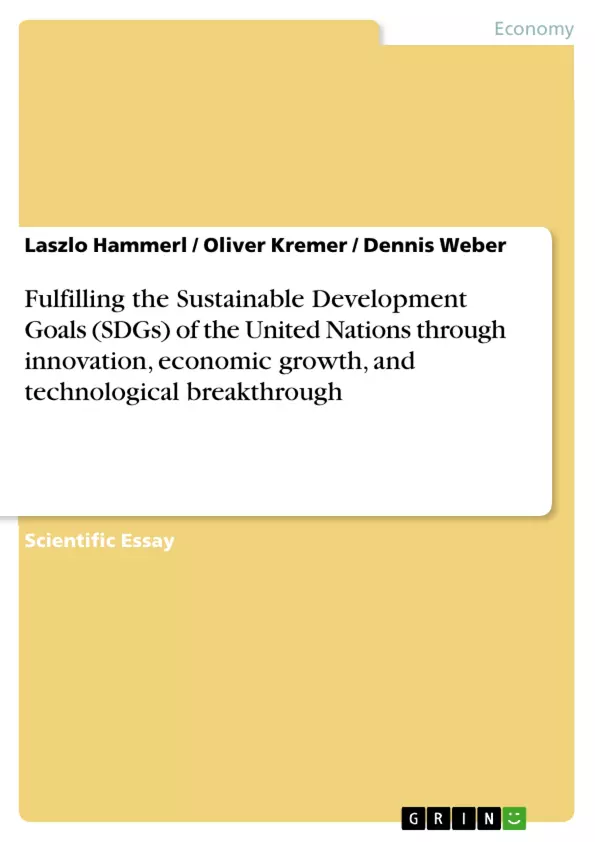The world around us is changing. While technical innovation is accelerating at unprecedented rates and delivering solutions that were unthinkable only a few decades ago, a new factor, impacting all sectors and industries alike, is becoming increasingly important: sustainability.
While sustainability is frequently referred to as a new science, one among many, a deeper examination indicates that it is not a distinct area. Instead, it's altering the way we think about all past studies and completely reorients the focus towards new facets. Material consumption, transportation routes, product-life cycles, recycling, and many more aspects demand increased consideration, resulting in the complete re-evaluation of processes. As a result, three term papers are presented that address the various domains of policymaking, the impacts of global migration and lastly the technological capabilities of artificial intelligence, in the framework of a scientific discourse. Topics take exemplary industrial fields to highlight the urgent call to action by NGOs, societies, and researchers alike. The Sustainable Development Goals (SDGs), also known as Global Goals, are a set of 17 interconnected global goals aimed at achieving a better and more sustainable future for everybody. The United Nations General Assembly established the Sustainable Development Goals (SDGs) in 2015, with the goal of achieving them by 2030. These goals are the cornerstones for the following essays.
The results of this research were presented in a shared colloquium in summer 2021. We would like to thank all institutional and private supporters who have actively helped us with this project and further research projects.
Table of Contents
- Achieving sustainability through national policymaking
- The Impact of Global Migration on the Desired Reduction of the Shortage of Skilled Workers in Germany
- Artificial Intelligence and the UNs Sustainable Development Goal #9
- Introduction
- Methodical approach
- Defining sustainable development
- Sustainability in the automotive sector
- Internal barriers of innovation inside German automotive sustainability
- External barriers of innovation inside German automotive sustainability
- Necessary steps towards the successful transition to automotive hydrogen technology
- Technological steps
- Legislative steps
- Hydrogen as a potential fuel alternative
- Conclusion
- References
Objectives and Key Themes
This research explores the multifaceted concept of sustainability, particularly in relation to the UN's Sustainable Development Goals (SDGs). The project aims to understand and address the challenges and opportunities of achieving a sustainable future through innovation, economic growth, and technological advancement. It does this by focusing on various industrial sectors and examining the impact of national policies, global migration, and artificial intelligence.
- The importance of sustainability as a transformative force across all sectors and industries.
- The role of national policymaking in achieving sustainable development.
- The potential impact of global migration on labor shortages and skilled workforce development.
- The contribution of artificial intelligence towards achieving the UN's Sustainable Development Goals.
- The need for a holistic approach to sustainability, considering environmental, social, and economic aspects.
Chapter Summaries
The first chapter examines the role of national policymaking in achieving sustainability, focusing on the German automotive industry and the potential of hydrogen as an alternative fuel source. It analyzes both internal and external barriers to the successful transition to hydrogen technology, outlining necessary steps towards achieving this goal. The second chapter explores the impact of global migration on the shortage of skilled workers in Germany, examining its potential contributions to achieving sustainable development. The third chapter delves into the application of artificial intelligence in achieving Sustainable Development Goal #9, highlighting its potential role in promoting innovation and sustainable industrial development.
Keywords
The primary focus of this work centers around the interconnected concepts of corporate sustainability, Sustainable Development Goals (SDGs), innovation, economic growth, technological breakthrough, national policymaking, global migration, artificial intelligence, hydrogen technology, and sustainable industrial development.
- Quote paper
- M. Sc. Laszlo Hammerl (Author), Oliver Kremer (Author), Dennis Weber (Author), 2021, Fulfilling the Sustainable Development Goals (SDGs) of the United Nations through innovation, economic growth, and technological breakthrough, Munich, GRIN Verlag, https://www.grin.com/document/1185488



